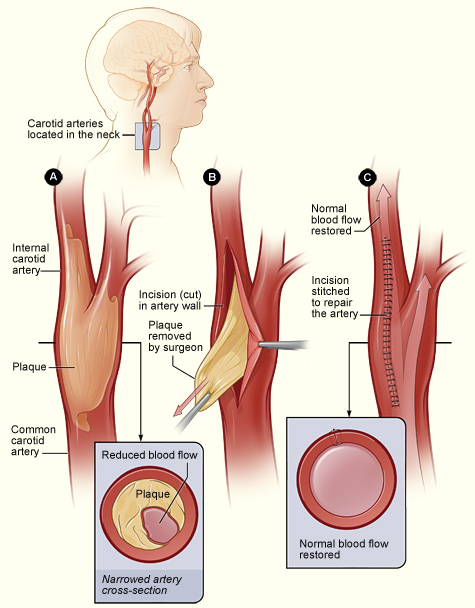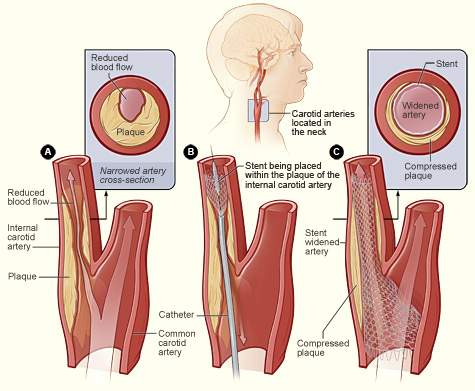How Is Carotid Artery Disease Treated?
Treatments for carotid artery disease may include
lifestyle changes, medicines, and medical procedures. The goals of treatment
are to stop the disease from getting worse and to prevent a
stroke.
Your treatment will depend on your symptoms, how
severe the disease is, and your age and overall health.
Lifestyle Changes
Making lifestyle changes often can help prevent
carotid artery disease or keep it from getting worse. For some people, these
changes may be the only treatment needed:
- Follow a healthy eating plan to prevent or lower
high
blood pressure and
high
blood cholesterol and to maintain a healthy weight.
- Increase your physical activity. Check with your
doctor first to find out how much and what kinds of activity are safe for you.
- If you're overweight or obese, lose weight.
- If you smoke, quit. Avoid exposure to secondhand
smoke.
Follow a Healthy Eating Plan
To help keep carotid artery disease from getting
worse, follow an eating plan that’s low in saturated and trans
fats, sodium (salt), and cholesterol. Therapeutic Lifestyle
Changes (TLC) and Dietary Approaches to Stop Hypertension (DASH) are two
examples of healthy eating plans.
TLC. Your doctor may recommend TLC
if you have high cholesterol. TLC is a three-part program that includes a
healthy diet, physical activity, and weight management.
With the TLC diet, less than 7 percent of your daily
calories should come from saturated fat. This kind of fat is mainly found in
meat and poultry, including dairy products. No more than 25 to 35 percent of
your daily calories should come from all fats, including saturated,
trans, monounsaturated, and polyunsaturated fats.
You also should have less than 200 mg a day of
cholesterol. The amounts of cholesterol and the different kinds of fat in
prepared foods can be found on the Nutrition Facts label.
Foods high in soluble fiber also are part of a
healthy eating plan. They help block the digestive tract from absorbing
cholesterol. These foods include:
- Whole grain cereals such as oatmeal and oat bran
- Fruits such as apples, bananas, oranges, pears,
and prunes
- Legumes such as kidney beans, lentils, chick
peas, black-eyed peas, and lima beans
A diet high in fruits and vegetables can increase
important cholesterol-lowering compounds in your diet. These compounds, called
plant stanols or sterols, work like soluble fiber.
Fish are an important part of a healthy diet.
They're a good source of omega-3 fatty acids, which help lower blood
cholesterol levels. Try to have about two fish meals every week. Fish high in
omega-3 fats are salmon, tuna (canned or fresh), and mackerel.
You also should try to limit the amount of sodium
that you eat. This means choosing low-sodium and "no added salt" foods and
seasonings at the table or when cooking. The Nutrition Facts label on food
packaging shows the amount of sodium in the item.
Try to limit drinks with alcohol. Too much alcohol
will raise your blood pressure and triglyceride level. (Triglycerides are a
type of fat found in the blood.) Alcohol also adds extra calories, which will
cause weight gain. Men should have no more than two drinks containing alcohol a
day. Women should have no more than one drink containing alcohol a day.
See the NHLBI’s
“Your
Guide to Lowering Your Cholesterol With TLC” for more information.
DASH. Your doctor may recommend the
DASH eating plan if you have high blood pressure. The DASH eating plan focuses
on fruits, vegetables, whole grains, and other foods that are healthy and lower
in salt/sodium.
This eating plan is low in fat and cholesterol. It
also focuses on fat-free or low-fat milk and dairy products, fish, poultry, and
nuts. The DASH eating plan is reduced in red meats (including lean red meat),
sweets, added sugars, and sugar-containing beverages. It's rich in nutrients,
protein, and fiber.
The DASH eating plan is a good healthy eating plan,
even for those who don’t have high blood pressure. See the NHLBI’s
"Your
Guide to Lowering Your Blood Pressure With DASH" for more information.
Increase Physical Activity
Regular physical activity can lower many carotid
artery disease risk factors, including LDL ("bad") cholesterol, high blood
pressure, and excess weight. Physical activity also can lower your risk for
diabetes and raise your levels of HDL cholesterol (the
“good” cholesterol that helps prevent plaque buildup).
Check with your doctor about how much and what kinds
of physical activity are safe for you. Unless your doctor tells you otherwise,
try to get at least 30 minutes of moderate-intensity activity on most or all
days of the week. You can do the activity all at once or break it up into
shorter periods of at least 10 minutes each.
Moderate-intensity activities include brisk walking,
dancing, bowling, bicycling, gardening, and housecleaning. More intense
activities, such as jogging, swimming, and various sports, also may be
appropriate for shorter periods.
See the NHLBI's
"Your
Guide to Physical Activity and Your Heart" for more information. Although
this guide focuses on heart health, it also applies to general health and
well-being.
Maintain a Healthy Weight
Maintaining a healthy weight can decrease risk
factors for carotid artery disease and stroke. Even a modest weight gain of a
few pounds a year can almost double your chances of having a stroke.
If you're overweight, aim to reduce your weight by 7
to 10 percent during your first year of treatment. This amount of weight loss
can lower your risk for carotid artery disease and other health problems.
After the first year, you may have to continue to
lose weight so you can lower your body mass index (BMI) to less than 25.
BMI measures your weight in relation to your height.
A BMI between 25 and 29 is considered overweight for adults. A BMI of 30 or
more is considered obese for adults. A BMI of less than 25 is the goal for
preventing and treating carotid artery disease.
You can find out your BMI using the NHLBI's
online calculator, or your
health care provider can measure your BMI.
For more information on losing weight and
maintaining your weight, see the Diseases and Conditions Index
Overweight
and Obesity article.
Quit Smoking
If you smoke or use tobacco, quit. Smoking can
damage your arteries and raise your risk for stroke and other health problems.
Talk to your doctor about programs and products that
can help you quit. The U.S. Department of Health and Human Services has
information on how to
quit smoking. Also, take steps to protect yourself from
secondhand smoke.
Medicines
You may need medicines to treat diseases and
conditions that damage the carotid arteries. High blood pressure, high blood
cholesterol, and diabetes can worsen carotid artery disease.
Some people can control these problems with
lifestyle changes. Others also need medicines to achieve and maintain control.
You may need antiplatelet (an-ty- PLATE-lit)
medicines to prevent blood clots from forming in your carotid arteries and
causing a stroke. Damage and plaque buildup make blood clots more likely.
Aspirin and clopidogrel are two common antiplatelet
medicines. They stop platelets from clumping together to form clots. These
medicines are a mainstay of treatment for people who have known carotid artery
disease.
Your health care team will help find a treatment
plan that’s right for you. Sticking to this plan will help avoid further
harm to your carotid arteries.
Procedures
You may need a medical procedure to treat carotid
artery disease. Doctors use one of two methods to open narrowed or blocked
carotid arteries.
Carotid Endarterectomy
This treatment is mainly for people whose carotid
arteries are blocked 50 percent or more.
For the procedure, a surgeon will make a cut in your
neck to reach the narrowed or blocked carotid artery. He or she will make a cut
in the artery and remove the plaque inside. The artery and your neck will then
be stitched up.
Carotid Endarterectomy

The illustration shows the process
of carotid endarterectomy. Figure A shows a carotid artery that has plaque
buildup. The inset image shows a cross-section of the narrowed carotid artery.
Figure B shows how the carotid artery is cut and the plaque removed. Figure C
shows the artery stitched up and normal blood flow restored. The inset image
shows a cross-section of the artery with plaque removed and normal blood flow
restored.
Carotid Artery Angioplasty and Stenting
Doctors use a procedure called
angioplasty (AN-jee-oh-plas-tee) to widen the carotid arteries
and restore blood flow to the brain.
A thin tube with a balloon on the end is threaded
through a blood vessel in your neck to the narrowed or blocked carotid artery.
Once in place, the balloon is inflated to push the plaque outward against the
wall of the artery.
A
stent
(a small mesh tube) is then put in the artery to hold the plaque back and keep
the artery open.
Carotid Artery Stenting

The illustration shows the process
of carotid artery stenting. Figure A shows an internal carotid artery that has
plaque buildup and reduced blood flow. The inset image shows a cross-section of
the narrowed carotid artery. Figure B shows a stent being placed in the carotid
artery to hold back plaque and keep the artery open. Figure C shows normal
blood flow restored in the stent-widened artery. The inset image shows a
cross-section of the stent-widened artery. |

